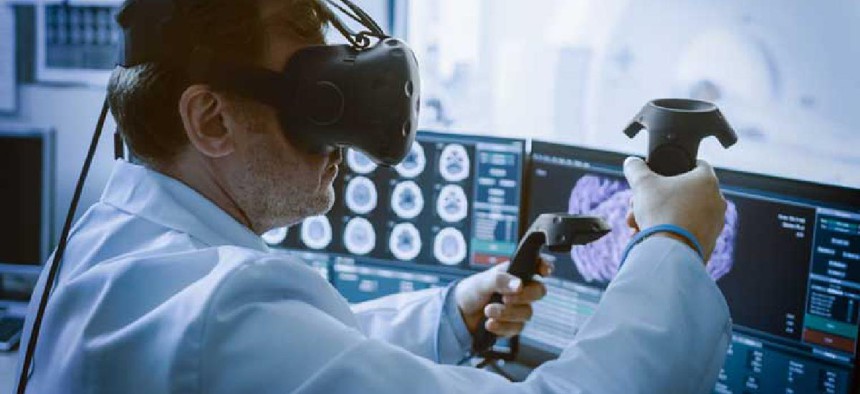DOD’s 5G foundation to support telerobotic surgery pilot
The Defense Department will be conducting 5G-based telemedicine pilots, experimenting with augmented reality medial training and robotic surgery.
The Defense Department is preparing for 5G-based telemedicine experiments with technologies such as augmented reality (AR) and robotic surgery.
DOD is expected to issue requests for prototype proposals from Joint Base San Antonio (JSBA) in Texas after releasing a statement of work for a 5G telemedicine and medical training project. The SOW sought industry input on development related to 5G-enabled AR/virtual reality-guided medical training, advanced telehealth information access, advanced robotic surgery and telementoring via AR for medical procedures.
The 5G network is critical to telemedicine because it shifts from the voice-centric 4G network to application-to-application communication without human intervention, National Spectrum Consortium (NSC) Vice Chairman Randy Clark said.
Considering military hospitals, Department of Veterans Affairs medical facilities and the sheer number of people DOD is responsible for taking care of at peacetime and at war, it becomes “a very important strategic decision to modernize, leveraging the benefits of 5G for health care,” Clark said.
With 5G, telemedicine stands to become more efficient as providers diagnose and care for people while they are at home. What’s more, 5G-supported business process improvement and robotics mean that cardiovascular surgeons could put their expertise to use anywhere in the world, even performing AR- and VR-assisted robotic surgery. That spreads knowledge exponentially, especially for an organization with constituents worldwide.
“The network, through cognition and [artificial intelligence], will be able to make decisions in milliseconds … perhaps hundreds of thousands of decisions in milliseconds,” Clark said. “This is why we have to harness and accelerate the disruptive technologies in the ecosystem around 5G to create those advantages for our economic strength, and our economic strength is ultimately our best national defense.”
Experiments in the four technical areas DOD specified will include the design and development of full-scale prototypes of 5G telemedicine applications running in real time on a the JSBA 5G core network. For instance, the purpose of AR-guided medical training is to prototype and demonstrate the application of the network to enhance in-garrison or just-in-time medical training.
The 5G Advanced Telehealth Information Access experiment will provide mobile enhancements that can handle on-demand, near-real-time and low-latency access to electronic health records. The final two experimentation areas focus on remote telerobotic surgery and the use of real-time 3D imagery and surgical video for tactical or airborne medical care.
“The experimental areas that the government chose to prioritize pre-dated COVID,” Clark said, adding that “there will probably be long-term benefits to this experimentation and the reference architectures that are created for COVID and other pandemic-related crises that we could potentially see in the future.”
In December 2020, DOD awarded 400-member NSC the Spectrum Forward OTA, which has a term of five years and a ceiling of $2.5 billion. Under it, NSC members will “perform coordinated research and development projects designed to accelerate streamlining and upgrading of communications infrastructure, improving efficient spectrum utilization, and advancing microelectronics to enable protected and resilient networks,” according to a press statement.
The first phase of DOD’s effort is the largest full-scale 5G test for dual-use applications in the world, according to a Jan. 6 announcement. The telemedicine testing is part of the second phase, or Tranche 2.
“We’re really trying to reach out to the entire 5G industry -- from the big companies to the traditional defense industrial base, and to small businesses and startups that are trying to create new and interesting technologies in 5G that can support DOD missions,” said Joseph Evans, principal director for 5G in the Office of the Under Secretary of Defense for Research and Engineering. “We’re focused on getting those solicitations out and making sure we get the best players providing technologies to DOD.”
This article first appeared on GCN, a Defense Systems partner site.




